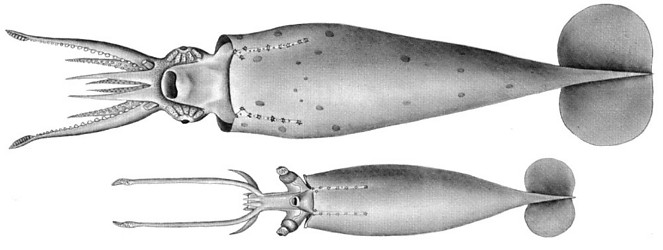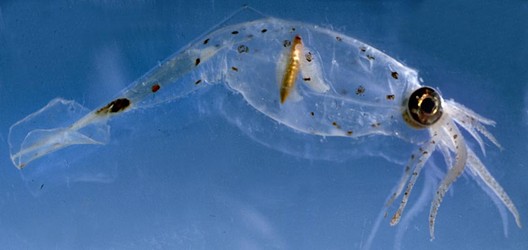Leachia dislocata
Richard E. Young and Katharina M. Mangold (1922-2003)Introduction
Brief diagnosis:
A Leachia with ...
- a complex tubercule, displaced medially, at anterior end of mantle strip.
- adult having completely sessile eyes.
Characteristics
- Head
- Beaks: Descriptions can be found here: Lower beak; upper beak.
- Beaks: Descriptions can be found here: Lower beak; upper beak.
- Mantle
- Length of cartilagenous strip 12-17% of ML.
- Complex tubercle at anterior end of strip displaced medially.
 Click on an image to view larger version & data in a new window
Click on an image to view larger version & data in a new window
Figure. Ventral view of the anterior end of one cartilagenous strip on the mantle of L. dislocata, 136 mm GL. Drawing from Young, 1972.
- Photophores
- On the adult eyeball, eight photophores comprise the outer series and the inner series (i.e., near the lens) consists of 7 photophores: two small photophores dorsal to the lens and five, three large organs alternate with two small ones, ventral to it.
 Click on an image to view larger version & data in a new window
Click on an image to view larger version & data in a new window
Figure. Two views of the ocular photophores of L. dislocata, 143 mmm GL.
- On the adult eyeball, eight photophores comprise the outer series and the inner series (i.e., near the lens) consists of 7 photophores: two small photophores dorsal to the lens and five, three large organs alternate with two small ones, ventral to it.
Comments
More details of the description can be found here.
The distinctive displaced tubercule on the cartilagenous strip is shared with Leachia pacifica.
Life History
The paralarva or the "pyrgopsis stage" has stalked eyes and few if any ocular photophores. The mature female has sessile eyes with a full compliment of photophores, relatively longer arms and photophores on the tips of arms III.


Figure. Ventral views of two life-history stages of L. dislocata, off southern California. Top - Adult female, 145 mm GL. Bottom - Paralarva, 27 mm GL. Drawings from Young (1972).
Ocular photophores are gradually added through growth.


Figure. Development of photophore compliment on eyes with growth in L. dislocata. Two views of each eye shown. A - 16 mm GL. B - 22 mm GL. C - 25 mm GL. D - 35 mm GL. E - 44 mm GL. F - 64 mm GL. G - 125 mm GL (holotype). H - 143 mm GL. Drawings from Young (1972).
Distribution
The type locality is 32°35'N, 118°06'W, off southern California in the eastern North Pacific. Also known from off the Pacific coast of Baja California at 27°45'N (Okutani, 1979).
References
Okutani, T. 1974. Epipelagic decapod cephalopods collected by micronekton tows during the EASTROPAC expeditions, 1967-1968 (systematic part). Bull. Tokai Reg. Fish. Res. Lab., 80: 29-118.
Voss, N. A. 1980. A generic revision of the Cranchiidae (Cephalopoda; Oegopsida). Bull. Mar. Sci. 30: 365-412.
Young, R. E. 1972. The systematics and areal distribution of pelagic cephalopods from the seas off Southern California. Smithson. Contr. Zool., 97: 1-159.
Title Illustrations

| Scientific Name | Leachia dislocata |
|---|---|
| Location | Off Southern California |
| Specimen Condition | Live Specimen |
| View | Side |
| Size | 100 mm ML (estimate) |
| Image Use |
 This media file is licensed under the Creative Commons Attribution-NonCommercial License - Version 3.0. This media file is licensed under the Creative Commons Attribution-NonCommercial License - Version 3.0.
|
| Copyright |
©

|
| Scientific Name | Leachia dislocata |
|---|---|
| Location | Off Southern California |
| Reference | from Young, R. E. 1972. The systematics and areal distribution of pelagic cephalopods from the seas off Southern California. Smithson. Contr. Zool. 97:1-159. |
| Acknowledgements | Drawing by Constance McSweeny. |
| View | Ventral |
| Size | 110 mm ML |
| Image Use |
 This media file is licensed under the Creative Commons Attribution-NonCommercial License - Version 3.0. This media file is licensed under the Creative Commons Attribution-NonCommercial License - Version 3.0.
|
| Copyright |
©

|
About This Page

University of Hawaii, Honolulu, HI, USA
Katharina M. Mangold (1922-2003)

Laboratoire Arago, Banyuls-Sur-Mer, France
Page copyright © 2018 and Katharina M. Mangold (1922-2003)
 Page: Tree of Life
Leachia dislocata .
Authored by
Richard E. Young and Katharina M. Mangold (1922-2003).
The TEXT of this page is licensed under the
Creative Commons Attribution-NonCommercial License - Version 3.0. Note that images and other media
featured on this page are each governed by their own license, and they may or may not be available
for reuse. Click on an image or a media link to access the media data window, which provides the
relevant licensing information. For the general terms and conditions of ToL material reuse and
redistribution, please see the Tree of Life Copyright
Policies.
Page: Tree of Life
Leachia dislocata .
Authored by
Richard E. Young and Katharina M. Mangold (1922-2003).
The TEXT of this page is licensed under the
Creative Commons Attribution-NonCommercial License - Version 3.0. Note that images and other media
featured on this page are each governed by their own license, and they may or may not be available
for reuse. Click on an image or a media link to access the media data window, which provides the
relevant licensing information. For the general terms and conditions of ToL material reuse and
redistribution, please see the Tree of Life Copyright
Policies.
- Content changed 16 November 2016
Citing this page:
Young, Richard E. and Katharina M. Mangold (1922-2003). 2016. Leachia dislocata . Version 16 November 2016 (under construction). http://tolweb.org/Leachia_dislocata/19588/2016.11.16 in The Tree of Life Web Project, http://tolweb.org/










 Go to quick links
Go to quick search
Go to navigation for this section of the ToL site
Go to detailed links for the ToL site
Go to quick links
Go to quick search
Go to navigation for this section of the ToL site
Go to detailed links for the ToL site